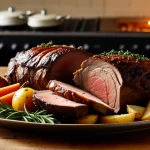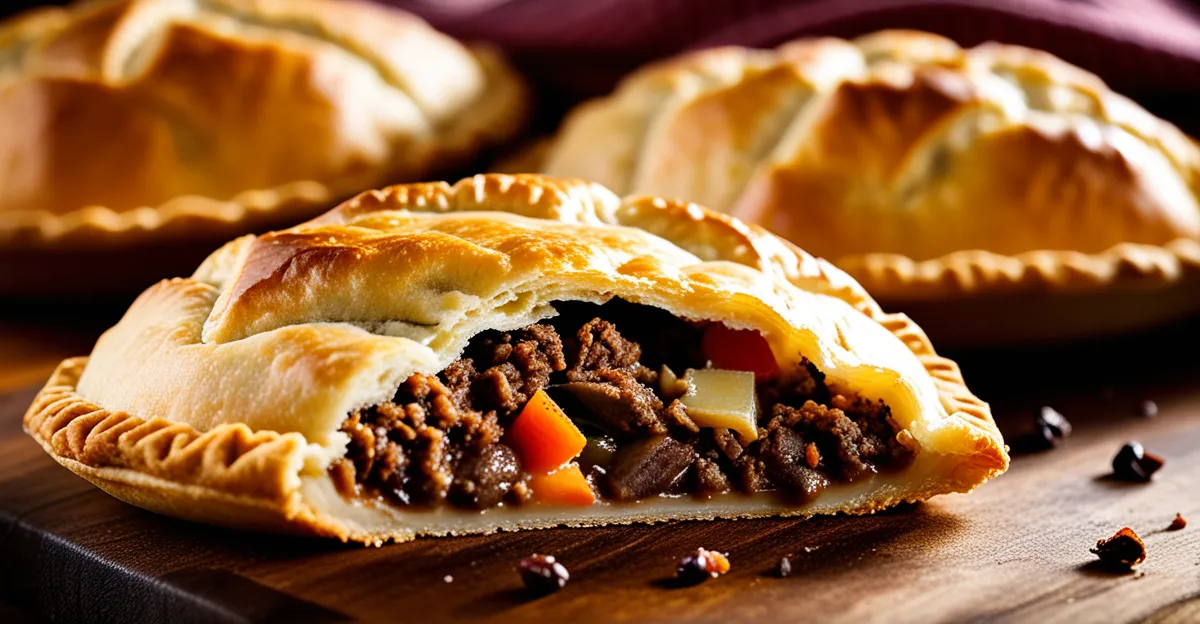Understanding the Classic Cornish Pasty
The traditional Cornish pasty ingredients form the foundation of an authentic pasty recipe. Core to this beloved dish are diced beef skirt or chuck steak, potatoes, swede (also known as rutabaga), and onions. Each filling component serves a specific purpose: the beef provides rich, robust flavour and protein; potatoes add heartiness and absorb juices; swede introduces subtle sweetness and firmness; while onions contribute aromatic depth.
The pasty’s distinctive pastry, a sturdy shortcrust, is essential. Its thick, flaky nature ensures the pasty holds up during cooking and handling. The iconic D-shaped hand-crimped edge isn’t just traditional—it also serves a practical role. Historically, miners held the crimped edge as a clean handle, avoiding contamination from dirty hands.
Also to read : What Innovative Dishes Can You Create Using Traditional UK Ingredients?
Together, these elements define the Cornish pasty basics. The precise balance of ingredients and the structured pastry work harmoniously to create the signature experience that an authentic pasty recipe promises: robust flavour, satisfying texture, and unmistakable heritage. This balance remains crucial when exploring filling variations or adaptations.
Creative Ingredient Alternatives for the Filling
Exploring fresh flavours while respecting Cornish pasty traditions
In parallel : How can you recreate the flavors of a traditional Sunday roast at home?
Alternative pasty fillings extend the appeal of this classic dish beyond the traditional Cornish pasty ingredients. Popular modern Cornish pasty substitutions include chicken for meat variations and mushroom or cheese for vegetarian options, providing new textures and tastes without overwhelming the pasty’s essence. For instance, diced chicken can offer a lighter protein complement, while mushrooms add umami depth somewhat akin to the rich beef in the authentic pasty recipe.
Vegetable options are expanding too. Seasonal choices like butternut squash or spinach incorporate natural sweetness and nutrition, diversifying the palate while maintaining hearty satisfaction. These new pasty ingredients can be combined with subtle herbs such as thyme or rosemary to enhance, rather than mask, the filling’s character.
Experimentation encourages balancing moisture levels carefully—too much can weaken the pastry, while too little risks dryness. Effective layering of flavours means considering how these ingredients interact with the classic pastry and its signature hand-crimped edge, which continues to seal in freshness and maintain the iconic shape key to the Cornish pasty basics.
Techniques for Successful Ingredient Substitution
Experimenting with pasty ingredients requires careful attention to balance. When you modify the Cornish pasty, moisture control is essential. Too much moisture from alternative fillings can cause the pastry to become soggy, while too little leads to dryness and a crumbly texture. For instance, watery vegetables like mushrooms should be pre-cooked or drained to reduce excess liquid.
Balancing pasty flavours involves layering ingredients thoughtfully without overpowering the subtle harmony found in the authentic pasty recipe. Combining herbs like thyme or rosemary with mild proteins or vegetables introduces complexity while respecting traditional tastes. It’s also crucial to ensure fillings cook evenly. Denser or larger chunks of substituted ingredients may require adjustments in cooking time or cutting sizes.
Moreover, successful substitution maintains the pastry’s integrity and iconic shape. A sturdy pastry dough paired with the recognized hand-crimped edge helps seal in new fillings, preserving texture and freshness. This approach allows innovation while honouring the Cornish pasty basics, keeping the dish satisfying and true to its origins.
Maintaining Authenticity While Experimenting
Balancing creativity with tradition is key to preserving the authentic Cornish pasty experience. Certain elements, such as the thick, sturdy pastry and the hand-crimped edge, must remain intact to respect pasty traditions. These features not only define the pasty’s iconic look but ensure proper sealing and cooking performance.
Regional guidelines often dictate that a true Cornish pasty include specific ingredients like beef skirt, potato, swede, and onion, but creative variations can still honour these standards by maintaining similar textures and flavour balance. For example, swapping beef with chicken retains the protein foundation while respecting the original concept.
To preserve pasty authenticity during experimentation:
- Maintain the essential pasty shape and crimp style.
- Mimic the moisture and density of traditional fillings to prevent sogginess or dryness.
- Use complementary herbs and spices cautiously, so they enhance but don’t overpower classic flavours.
By holding to these fundamentals, you can create innovative pasties that remain true to the authentic Cornish pasty legacy without sacrificing taste or tradition.
Practical Tips, Do’s and Don’ts for Ingredient Experimentation
When experimenting with alternative pasty fillings, careful preparation is vital to maintain the pasty’s signature texture and shape. Always pre-cook or thoroughly drain moist vegetables like mushrooms or spinach to avoid soggy pastry—a common pitfall in pasty cooking tips. Cutting ingredients into uniform sizes also promotes even cooking, ensuring no portion remains underdone.
Avoid overloading the pastry with too many wet or heavy ingredients, as this can compromise the Cornish pasty basics structure. Balancing moisture is crucial. Use less juicy vegetables or add absorbent fillers like potatoes to help maintain firmness. When mixing, handle the dough gently to preserve its flakiness and prevent tearing.
Pay particular attention to the iconic hand-crimped edge. Improper sealing leads to filling leakage during baking. Practice careful folding and pressing to securely encase the filling, which preserves the pasty’s traditional look and function.
By following these best practices, you safeguard your authentic pasty recipe’s integrity while exploring fresh new pasty ingredients confidently and successfully.








